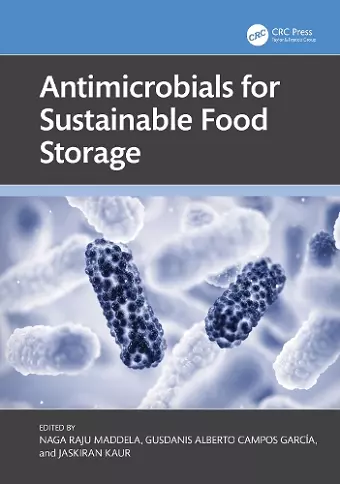Antimicrobials for Sustainable Food Storage
Naga Raju Maddela editor Jaskiran Kaur editor Gusdanis Alberto Campos Garcia editor
Format:Hardback
Publisher:Taylor & Francis Ltd
Published:13th Aug '24
Currently unavailable, and unfortunately no date known when it will be back

Finding natural substances is worthwhile in food preservation. The principal motivation behind this edited volume, Antimicrobials for Sustainable Food Storage,is to collect and present widespread knowledge in the domain of sustainable food ingredients with antimicrobial properties. The book consists of two sections. The first section of this volume is about food ingredients as antimicrobials, and the second section discusses the recent advances in the applications of food ingredients.
Interplay of various environmental factors favors the growth of different microorganisms during the food preservation process. Growth of undesirable microorganisms negatively influences the taste, smell, color, and texture of food. Therefore, sustainable food preservation is a challenging issue. Though several chemicals have emerged, inevitable health effects are commonly encountered by food preserve chemicals.
Microbial products (nisin, enterocin, pentosin, sakacin, and pediocin) have immense importance in prolonging the shelf life of food substances by controlling food spoilage and pathogenic microbes. Yeasts and cyanobacteria are also potential candidates in the supply of food ingredients with significant antimicrobial properties. However, limited awareness of antimicrobials as food ingredients and the unavailability of a single source of the latest insights on such food ingredients in one place led to the motivation to produce this work.
Key Features:
- Provides insights on natural antimicrobials in food preservation
- Underlines the importance of sustainable food packaging
- Offers knowledge on emerging trends in antimicrobial-based food storage
Diverse applications are covered in different chapters. This book covers various antimicrobials as food preservatives, such as metabolites, natural products, essential oils, nanomaterials, L-arginine, polyphenols, phaeophyceae, and horchata. There are also chapters that focus on the applicability and prospective studies of essential oils, edible biofilms, biodegradable antimicrobials, and nanostructured lipid carriers in the food sector and the method for encapsulation of antimicrobials.
ISBN: 9781032264851
Dimensions: unknown
Weight: 961g
372 pages